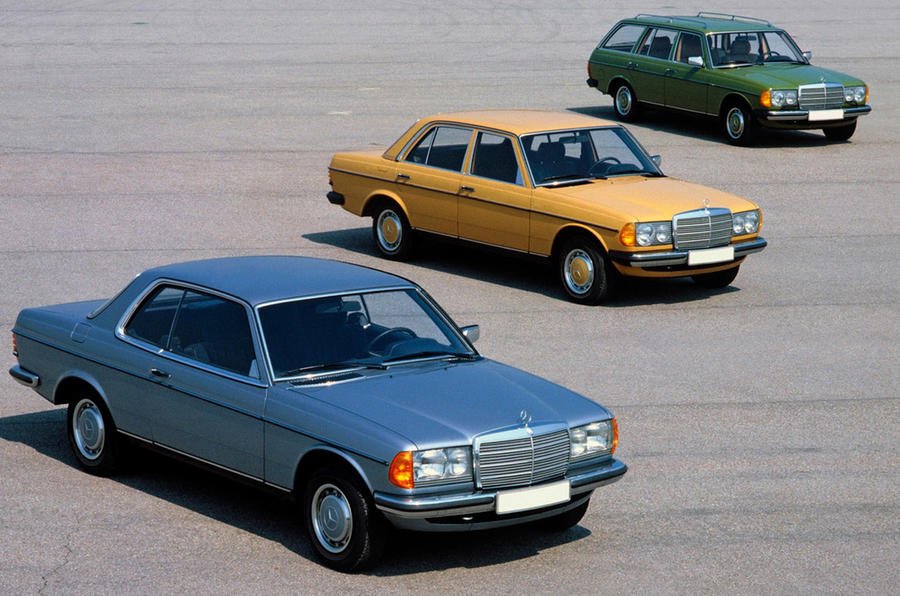To exude both class and indestructibility, a car must at once be built like a Challenger tank and make more concessions to luxury than a Four Seasons hotel.
It's a winning and increasingly popular formula, but even today's tech-rich efforts can't hold a candle to the Mercedes-Benz W123.
Introduced in 1976 as an evolution rather than reinvention of the W114, the W123 spawned a total of four bodystyles and went on to surpass even the astounding sales success of its forebear, shifting 2.7 million units over its 10-year production run.
Expensive in all forms from new, the W123 could be specified with an overwhelming range of petrol and diesel motors, the most dependable of which helped to secure its place in the hearts of taxi drivers around the globe. Many are recorded as having covered upwards of 500,000 miles without much more than regular services, although the doorless 1983 230E that took James May across Botswana in a 2007 episode of Top Gear is probably a better known testament to the car's durability.
The car commanded a heavy premium over its rivals – a starting price of £8000 in 1979 translates to £41,000 today – but a large portion were run on a tight budget, and the results are plain to see today: available models range from basket-case barn finds (steer well clear) to concours cars that have been restored at great expense to their owners.
The handsome estate version – badged T for 'tourismus und transport' – is the most unattainable variant, prices now edging past what you might pay for a clean two-door 'pillarless' CE coupé, but the saloon is just about still within the realm of the casual enthusiast.
The marketplace is mostly populated by 230E models, which, as the designation suggests, pack a 2.3-litre four-cylinder petrol motor with a healthy 134bhp, but there are plenty of less potent 200 examples still up for grabs. The top-rung 280E's straight-six petrol was said to be capable of pushing the W123 to 124mph, but beware earlier carburetted versions, which are thirstier than those equipped with the Bosch fuel injection system.
Don't expect such pace from naturally aspirated diesels, whose pedestrian nature was instrumental in their famed longevity. The 300TD – featuring the world's first turbodiesel motor for a passenger car – didn't come to the UK originally, but clean examples can be found Stateside and across Europe. While there remains a healthy selection of W123s in the classifieds, its ongoing popularity is threatened by a lack of aftermarket support from Mercedes, which means that fully restored examples are often sold on at a heavy loss by owners. Usable parts can be nabbed from the plethora of crusty examples being broken in the UK and abroad, and pattern body panels are available through suppliers including Niemöller and Mecatechnic.
How to get one in your garage
An expert's view
Mark Cosovich, W123 World: "If you're considering a W123, don't take on anything with a high mileage or any projects that nobody wants and nobody can finish. Even if it's been restored, get a specialist to look at it, because they're out there with the wrong interiors and engines swapped into them. You won't find good cars on eBay, either; anything that's good will be offered via private sale or from a specialist who is happy to put a warranty on it."
Buyer beware...
■ Engine: Fuel injection cars can do massive mileages if they're correctly serviced, but the extensive Bosch system rather inhibits engine access. Look out for signs of timing chain failure.
■ Electrics: Check for vacuum leaks in the central locking system, which also locks the front seats in place. Odometer is a known weak spot, so check that the seats and pedals are as worn as the mileage suggests.
Back to top
■ Body: Rust is common on early cars because of quality steel shortages in the 1970s. Look for repairs to the wheel arches, door bottoms, battery tray and sunroof, and make sure the original rubberised chassis coating isn't hiding anything serious.
■ Interior: Not much trim is available now, but optional textured vinyl (MB Tex) is the toughest stuff around so should not suffer wear badly. Fabric upholstery is tough to restore, and the velour interiors are all but extinct now. Look for leaky windscreen seals.
■ Gearbox: As durable as the engines but still require servicing and maintenance. Check for overly jerky changes and clunky shifts, which a vacuum control valve adjustment will usually rectify.
■ Suspension: Estate cars have hydraulic self-levelling suspension (SLS) as standard, most of which will want an overhaul by now. This requires specialist knowledge and parts fabricated. Saloons usually had springs in the rear, but a dragging tail is a sign that SLS was specified.
Also worth knowing
Later models are, predictably, the ones to seek out. A 1982 facelift brought various upgrades including power steering as standard, improved rear leg room, a driver’s airbag and an optional five-speed manual gearbox.
How much to spend
£1000-£1999: Neglected saloons that need some welding and an engine overhaul at the very least, making restoration not a cost-effective prospect.
£2000-£4499: Solid, usable four-door and estate models with long MOTs and rust-free underbellies. Beware of cars with a taxi firm listed on the logbook, as they will have led a hard life.
£4500-£14,999: The safest section of the W123 market. Well-kept examples and ageing restorations, including a rare 1978 saloon with its original round headlights for £6995.
£15,000-£30,000: Showroom-condition coupés and estates, mostly from private collections, with extensive history and well-preserved interiors.
One we found
Mercedes-Benz 200T W123 Estate, 1985/C-Plate. 94K miles, £6995: It's fitted with the less desirable 2.0-litre engine, but this privately sold estate has fewer miles than most and has been in the same family for nearly 30 years.
Похожие новости

